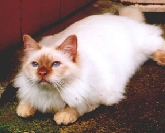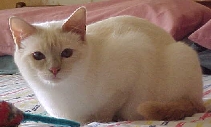Basic Colours and Patterns
COLOURS
There are in fact only two colours in the
Birman, or any other cat for that matter, and those are BLACK
and RED. All other colours are mutations or
modifications, either to the pigment itself, or the arrangement
in the hair shaft.
The gene responsible for the Siamese
pattern of the Birman, is a member of the albino series. Its
effect reduces the amount of pigment in the pigment granules,
giving the appearance of a paler point colour, such as seal, to
its corresponding full pattern of black.
BLACK (B)
 | ||
|
Rakesha Fudge Frosting
Cinnamon Pt
| ||
|
PURE SEAL (BB) X CHOCOLATE
CARRYING CINNAMON (b bl)
| ||
| |||||||||||
RED (O)
The red gene is a sex linked gene carried
on the X chromosome, of which males normally only have one (XY)
and females two (XX). Therefore the male can only have
one red gene on his one X chromosome, where the female can have
one red and one non-red (tortie) or two red.
Red masks the presence of seal, chocolate
or cinnamon, when it converts all black pigment to red. The
non-agouti (unbanding) gene acts only on black pigment,
therefore hairs containing red pigment will always have agouti
banding. As a result there is no visible difference
between red and red tabby, they will both exhibit the tabby
pattern.
 | ||
DILUTE (d)
Dilute colours come about when the normal
densely arranged pigment granules of the seal, clump up and
scatter in the hair shaft causing a dilute effect.
PATTERNS
|
Rakesha Golden Girl
Fawn Pt
| ||
TABBY (Agouti) (A)
Tabbies arise from a combination of two
separate patterns, each acting independently. The tabby
pattern itself, responsible for the solid coloured
barring in the mackerel (T)and blotched (t) tabbies, and the
agouti pattern (Ta), (as seen in the Abysinnian) in which the
guard hair shafts, in between the tabby pattern, are composed
of a dark tip separated by a yellow band (known as the agouti
band) followed by a dark base.
Birman breeders need not concern themselves
with the type of tabby pattern their cat may be, as barring is
restricted to the points, making pattern changes less obvious,
however, the abyssinian tabby, may not display an acceptable
degree of barring, due to the fact that almost all of the guard
hairs are banded and barring has been virtually eliminated.
While undesirable for the exhibition tabby, it can be used to
advantage in reducing barring in reds.
PLAIN (a)
Plain point or non-agouti results when the
agouti bands have been eliminated from the hair shafts located
between the tabby bars, thus creating the appearance of solid
colouring. This can be substantiated by the ghost barring
often noticeable in kittens.
The saying "all cats are tabbies"
actually means all cats have the tabby barring pattern, not all
have the agouti pattern. The confusion lies in the fact
that tabbies must have both patterns to be expressed as tabbies
i.e. all tabbies are agouti.
SILVER (I)
Silvers possess the dominant gene known as
the inhibitor gene, so called because of its nature of
inhibiting the development of pigment in the more lightly
pigmented areas of the coat, such as the undercoat towards the
roots and the agouti or yellow areas of the coat. Consequently
the tabby pattern stands out against a white background. The
degree of silver is influenced by polygenes and may vary from
low to high grade.
MODIFIED COLOUR AND PATTERN COMBINATIONS
|
|
SEAL
|
CHOCOLATE
|
CINNAMON
|
RED
|
SEAL TORTIE
|
|
TABBY
|
SEAL TABBY
|
CHOCOLATE TABBY
|
CINNAMON TABBY
|
RED TABBY
|
SEAL TORTIE TABBY
|
|
DILUTE
|
BLUE
|
LILAC
|
FAWN
|
CREAM
|
BLUE TORTIE
|
|
SILVER
|
SEAL SMOKE
|
CHOCOLATE SMOKE
|
CINNAMON SMOKE
|
RED SMOKE
|
SEAL TORTIE SMOKE
|
|
TABBY & DILUTE
|
BLUE TABBY
|
LILAC TABBY
|
FAWN TABBY
|
CREAM TABBY
|
BLUE TORTIE TABBY
|
|
TABBY & SILVER
|
SEAL SILVER TABBY
|
CHOCOLATE SILVER TABBY
|
CINNAMON SILVER TABBY
|
RED SILVER TABBY
|
SEAL SILVER TORTIE TABBY
|
|
DILUTE & SILVER
|
BLUE SMOKE
|
LILAC SMOKE
|
FAWN SMOKE
|
CREAM SMOKE
|
BLUE TORTIE SMOKE
|
|
TABBY DILUTE & SILVER
|
BLUE SILVER TABBY
|
LILAC SILVER TABBY
|
FAWN SILVER TABBY
|
CREAM SILVER TABBY
|
BLUE SILVER TORTIE TABBY
|
Tabby and silver are dominant genes,
therefore they only need one parent displaying them in order to
be produced, whereas to produce a dilute the recessive gene
must be carried by both parents.
Home | History | The Cats | Kittens | Basic Genetics | Coat Colour Chart
| White Spotting
| Silver Gene
| Wobblers
| Links | E-Mail
|